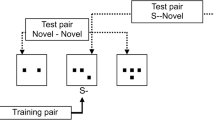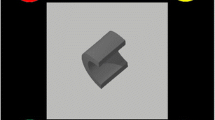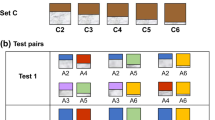Abstract
Two pigeons learned to respond to four objects while withholding response to two objects. The birds maintained their numerical discrimination when new objects were introduced. They also maintained the discrimination when large and small objects were used to construct “2” and “4,” and when different kinds of objects were mixed to make “2” and “4.” The subjects responded most often to four objects when tested with one, two, three, four, and five objects in the generalization test after fourth discrimination task. These results suggest the ability of numerical discrimination in pigeons. Two other birds that were trained to peck two objects but not to peck four objects showed, however, severe difficulty in learning this task. Thus, pigeons’ ability for numerical discrimination is affected by training procedure.
Similar content being viewed by others
References
ARNDT, W. (1939). Abschliesende Versuche zur Frage der “Zahl” Vermoegens de Haustaube. Zeitschrift fuer Tierpsychologie, 3, 88–142.
BOYSEN, S. T., & CAPALDI, E. J. (Eds.). (1993). The development of numerical competence. Mahwah, NJ: Lawrence Erlebaum Associates.
CAPALDI, E. J., MILLER, D. J., & ALPTEKIN, S. (1989). A conditional numerical discrimination based on qualitatively different reinforcer. Learning & Motivation, 20, 48–59.
DAVIS, H. (1984). Discrimination of the number three by a raccoon (Procyon lotor). Animal Learning and behavior, 12, 409–419.
DAVIS, H., & BRADFORD, S. A. (1986). Counting behavior by rats in a simulated natural environment. Ethology, 73, 265–280.
DAVIS, H., & MEMMOTT, J. (1982). Counting behavior in animals: A critical evaluation. Psychological Bulletin, 92, 547–571.
DAVIS, H., & PERUSSE, R. (1988). Numerical competence in animals: Definitional issues, current evidence, and a new research agenda. Behavioral and Brain Sciences, 11, 561–615.
JENKINS, H. M., & Sainsbury, R. S. (1970). Discrimination learning with the distinctive feature on positive or negative trials. In D. I. Mostofsky (Eds.), Attention: Contemporary theory and analysis (pp. 239–276). New York: Appleton-Century-Crofts.
KOEHLER, O. (1941). Vom Lernen unbenannter Anzahlen bei Voegeln. Die Naturwissenschaften, 29, 201–218.
KOEHLER, O. (1951). The ability of birds to “count.” Bulletin of Animal behavior, 9, 41–45.
LOEGLER, P. (1959). Versuche zur Frage des Zahl-vermoegens an einem Graupapegei und Vergleichendeversuche an Menschen. Zeitschrift fuer Tierpsychologie, 16, 169–217.
MAROLD, E. (1939). Versuche an Wellensittichen zur Frage des “Zahl” vermoegens. Zeitschrift fuer Tierpsychologie, 3, 170–223.
PEPPERBERG, I. M. (1994). Numerical competence in an African Gray parrot (Psittacus erithacus). Journal of Comparative Psychology, 108, 36–44.
RENSCH, B., & ALTEVOGT, R. (1957). The intelligence of elephants. Scientific American, 421–427.
RILLING, M. E. (1967). Number of responses as a stimulus in fixed interval and fixed ratio schedules. Journal of Comparative and Physiological Psychology, 63, 60–65.
RILLING, M. E., & MCDIARMID, C. (1965). Signal detection in fixed-ratio schedule. Science, 148, 526–527.
ROBERT, W. A., MACUDA, T., & BRODBECK, D. R. (1995). Memory for number of light flashes in the pigeons. Animal Learning and behavior, 23, 182–188.
SCHIEMANN, K. (1939). Vom Erlernen unbenanntes Anzahlen bei Dohlen, 3, 292–347.
SEIBT, V. T. (1982). Zahlbegriff und Zaehlverhalten bei Tieren: Neue Versuche und Deutungen. Zeitschrift fuer Tierpsychologie, 60, 325–341.
SWENSON, L. C. (1970). One versus two discrimination by whitenecked ravens (Corvus cryptoleucus) with non-number discriminations varied. Animal behavior, 18, 454–460.
WATANABE, S. (1991). Effects of ectostriatal lesions on natural concept, pseudoconcept and artificial pattern discrimination in pigeons. Visual Neuroscience, 6, 497–506.
Author information
Authors and Affiliations
Corresponding author
Additional information
This research was supported by Grants in Aid for Promotion of Sciences (#05206113).
Rights and permissions
About this article
Cite this article
Watanabe, S. Discrimination of “Four” and “Two” by Pigeons. Psychol Rec 48, 383–391 (1998). https://doi.org/10.1007/BF03395279
Published:
Issue Date:
DOI: https://doi.org/10.1007/BF03395279




